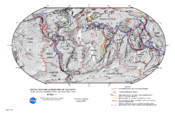Abstract
This paper will discuss how the Pacific Southwest region was formed according to the theory of plate tectonics. It will explain the theory of plate tectonics, which is the theory of how the continents move around on the mantle, and identify factors that influence the location and intensity of earthquakes and volcanoes for the region. The San Andreas Fault located in California, is a crack in the crust of the earth and is the main factor behind the earthquakes that shake the Pacific Southwest. The fault causes earthquakes as the west side of the plates moves north. The paper will also describe the main movement within the plate tectonics theory that shaped the form and composition of the selected region. It will also discuss the various geological events that occurred and the various types of rocks that the geological events formed. Finally, the paper will discuss the importance and economic value of rocks in the Pacific Southwest.
�
Explanation of the theory of plate tectonics
The plate tectonic theory is an amazing theory. It begins with defining the lithosphere, which is the outer layer of the earth. The lithosphere is relativity thin compared to the rest of the Earth. The lithosphere lies on top of a much weaker substance that is constantly in motion. This is called the asthenosphere, which is weak because of being at a temperature that is close to the melting point. The lithosphere maintains a solid state that allows it to float atop the asthenosphere (Merali, Z., & Skinner, B. J., 2009). The lithosphere broke off into seven large plates, each of these plates expand thousands of kilometers. When tectonic plates slide against one another, split apart, or collide the result of this can be very devastating. The outcomes of these actions may...


